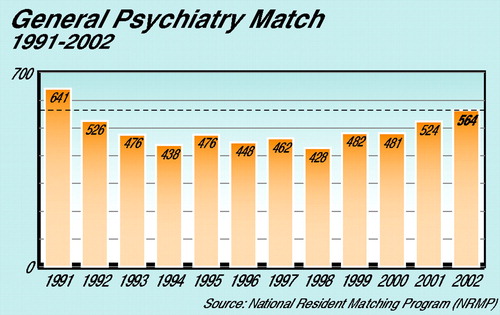Psychiatry Gaining Popularity Among U.S. Medical-School Graduates
The “era of the generalist”—when medical students responded to a widely perceived shortage of primary care physicians by flocking into family medicine—appears to be waning, if the results of this year’s National Resident Matching Program (NRMP) are any indication.
 Psychiatry would appear to be reaping a minor windfall from the shift. This year 564 U.S. senior medical students matched into PGY-1 psychiatry positions, up from 524 the previous year (see chart). In addition, 343 non-U.S. senior students entered the ranks of psychiatry, for a total of 907 students matching into PGY-1 psychiatry positions. That’s a 4 percent increase over 2001, and a 10 percent increase since 1998.
Psychiatry would appear to be reaping a minor windfall from the shift. This year 564 U.S. senior medical students matched into PGY-1 psychiatry positions, up from 524 the previous year (see chart). In addition, 343 non-U.S. senior students entered the ranks of psychiatry, for a total of 907 students matching into PGY-1 psychiatry positions. That’s a 4 percent increase over 2001, and a 10 percent increase since 1998.
There were 957 psychiatry positions offered in 2002, with 94.3 percent filled. This compares with a 93.5 percent fill rate in 2001 and a 90.4 percent fill rate in 2000, according to APA’s Division of Education, Minority, and National Programs.
“For the last several years, the numbers of U.S. students matching into psychiatry had been up and down, with no clear trend,” said James W. Thompson, M.D., M.P.H., director of the division. “However, we have now seen an increase for two years in a row, and we believe that this may be the beginning of an upward trend.”
Thompson noted, however, that the numbers of international medical graduates (IMGs) who matched in psychiatry, on whom psychiatry has increasingly relied over the last several years, decreased slightly in 2002 (343 versus 348 in 2001). Since 1998 there has been more than a 10 percent drop in IMGs matching into psychiatry, while the number of U.S. medical graduates has increased by 10 percent.
Thompson said there is some concern that the decrease in IMGs over the last two years may be due to the new Clinical Skills Assessment (CSA) exam, which is required of all IMGs and is given only once a year in Philadelphia. Many have complained that the exam is inaccessible to many international students, making it difficult or impossible for them to qualify for U.S. residency positions.
Thompson said the numbers of IMGs vying for residency positions in all of medicine has greatly decreased since the institution of the CSA exam.
“A decreased pool of IMGs would not be good news for several medical specialties, including psychiatry,” he said. “We need to work with other organizations to make the CSA exam more accessible. Otherwise, we could lose a valuable source of psychiatric manpower.”
Evidence of a return by medical graduates to subspecialization can be found in the fact that anesthesiology and diagnostic radiology—which only a few years ago were deemed to be on the ropes—continued a trend back to popularity.
Meanwhile, there was a decrease in residency positions filled in six primary care specialties: family practice, internal medicine, pediatrics, medicine-pediatrics, internal medicine primary, and pediatrics primary. There were 373 fewer U.S. seniors filling these generalist residency positions this year, with 205 fewer positions filled overall; IMGs made up the difference with 116 more matches to these positions than last year, according to the NRMP, which runs the yearly match.
In addition, there was a slight decrease this year in the number of U.S. medical school seniors matching to general surgery positions. Although the number of available positions in general surgery remained largely unchanged since 2001, the number of U.S. seniors filling those positions dropped from 820 in 2001 to 782 this year.
Observers suggest that the increase in students matching into psychiatry is related, at least in part, to a movement away from the push for primary care specialties.
“In the past decade, psychiatry’s worst U.S. recruitment years occurred during the most intense focus on generalist training and primary care,” said psychiatrist Sydney Weissman, M.D., a former president of the American Association of Directors of Psychiatric Residency Training with a longtime interest in workforce issues. He is president-elect of the American Society for Adolescent Psychiatry and on the faculty of Northwestern University.
“With the return to subspecialization as a focus on American medical students’ career choices, psychiatry has recruited more effectively, with essentially 4 percent of the class of 2002 entering the field.”
Weissman said he believes the resurgent popularity of fields like anesthesiology and radiology indicates the persistence of high income and lifestyle as predominant factors in the choices students make.
“U.S. senior medical student career choice is a dynamic process,” he said. “It is affected by long-term trends such as a focus by students on lifestyle and income. It is also impacted by near-term societal pressures, such as the brief focus on graduating primary care physicians. It is also impacted on a short-term basis by the immediate availability of jobs upon residency graduation.”
The “match” is the primary system that matches applicants to residency programs with available positions at U.S. teaching hospitals. It is sponsored by the AMA, American Board of Medical Specialties, Association of American Medical Colleges, American Hospital Association, and Council of Medical Specialty Societies. There were 23,459 active applicants in the 2002 match, including 14,336 U.S. medical school seniors, according to the NRMP. ▪



